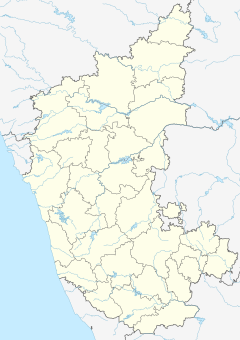| Chennakesava Temple (ಶ್ರೀ ಚೆನ್ನಕೇಶವ ದೇವಸ್ಥಾನ) | |
|---|---|
 Keshava temple at Somanathpura (also spelled Keshava temple, Somnathpur) | |
| Religion | |
| Affiliation | Hinduism |
| Deity | Keshava (Vishnu) |
| Location | |
| Location | Somanathapura, Mysuru, India |
| Geographic coordinates | 12°16′32.49″N 76°52′53.95″E / 12.2756917°N 76.8816528°E |
| Architecture | |
| Type | Hoysala architecture |
| Creator | Somanatha Dandanayaka |
| Completed | 1258[1] |
| Official name | Sacred Ensembles of the Hoysalas |
| Type | Cultural |
| Criteria | i, ii, iv |
| Designated | 2023 (45th session) |
| Reference no. | 1670[2] |
The Chennakesava Temple, also referred to as Chennakeshava Temple and Keshava Temple, is a Vaishnava Hindu temple on the banks of River Kaveri at Somanathapura, Mysuru, Karnataka, India.The temple was consecrated in 1258 CE by Somanatha Dandanayaka, a general of the Hoysala King Narasimha III. It is located 38 kilometres (24 mi) east of Mysuru city.[3][note 1]
The ornate temple is a model illustration of the Hoysala architecture. The temple is enclosed in a courtyard with a pillared corridor of small shrines (damaged). The main temple in the center is on a high star-shaped platform with three symmetrical sanctums (garbha-griha), set in a square matrix (89' x 89') oriented along the east–west and north–south axes.[4] The western sanctum was for a statue of Kesava (missing), the northern sanctum of Janardhana and the southern sanctum of Venugopala, all forms of Vishnu.[5] The sanctums share a common community hall (sabha-mandapa) with many pillars. The outer walls, the inner walls, the pillars and the ceiling of the temple are intricately carved with theological iconography of Hinduism and display extensive friezes of Hindu texts such as the Ramayana (southern section), the Mahabharata (northern section) and the Bhagavata Purana (western section of the main temple).[1]
The Chennakesava temple, states George Michell, represents the climax of the development in Hoysala temple style and yet is also unique in many ways.[6]
In 2023, the Somanathapura temple, along with the Hoysaleswara Temple at Halebidu and the Chennakeshava Temple at Belur, was declared a World Heritage Site by UNESCO as part of the Sacred Ensembles of the Hoysalas.[7]
- ^ a b Kirsti Evans (1997). Epic Narratives in the Hoysaḷa Temples: The Rāmāyaṇa, Mahābhārata, and Bhāgavata Purāṇa in Haḷebīd, Belūr, and Amṛtapura. BRILL Academic. pp. 10–11. ISBN 90-04-10575-1.
- ^ "Sacred Ensembles of the Hoysalas". UNESCO World Heritage Centre. Retrieved 24 September 2023.
- ^ Keshava Temple, Somnathpura,Mysore District Karnataka Archived 23 October 2017 at the Wayback Machine, Government of Karnataka, India
- ^ Margaret Prosser Allen (1991). Ornament in Indian Architecture. University of Delaware Press. p. 217. ISBN 978-0-87413-399-8.
- ^ Fredrick W. Bunce (2002). The Iconography of Architectural Plans: A Study of the Influence of Buddhism and Hinduism on Plans of South and Southeast Asia. DK. pp. 118–120. ISBN 978-81-246-0200-3.
- ^ George Michell (1977). The Hindu Temple: An Introduction to Its Meaning and Forms. University of Chicago Press. pp. 146–148. ISBN 978-0-226-53230-1.
- ^ Centre, UNESCO World Heritage. "Sacred Ensembles of the Hoysalas". UNESCO World Heritage Centre. Retrieved 29 June 2024.
Cite error: There are <ref group=note> tags on this page, but the references will not show without a {{reflist|group=note}} template (see the help page).

